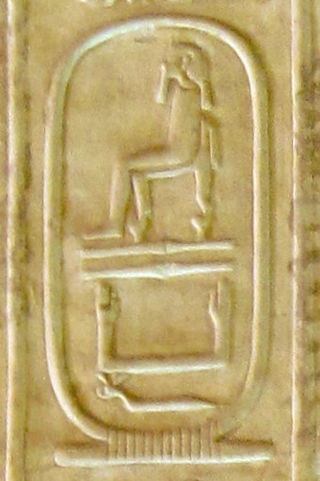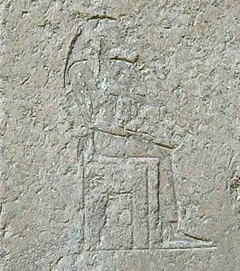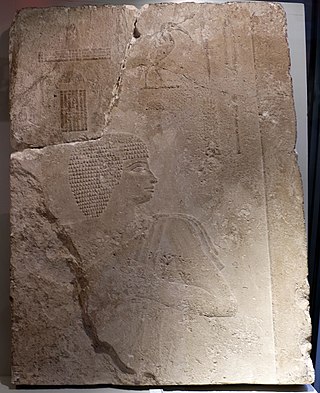Related Research Articles

The Egyptian pyramids are ancient masonry structures located in Egypt. Sources cite at least 118 identified "Egyptian" pyramids. Approximately 80 pyramids were built within the Kingdom of Kush, now located in the modern country of Sudan. Of those located in modern Egypt, most were built as tombs for the country's pharaohs and their consorts during the Old and Middle Kingdom periods.

The Fourth Dynasty of ancient Egypt is characterized as a "golden age" of the Old Kingdom of Egypt. Dynasty IV lasted from c. 2613 to 2494 BC. It was a time of peace and prosperity as well as one during which trade with other countries is documented.

Shepseskaf was a pharaoh of ancient Egypt, the sixth and probably last ruler of the fourth dynasty during the Old Kingdom period. He reigned most probably for four but possibly up to seven years in the late 26th to mid-25th century BC.

The Giza pyramid complex in Egypt is home to the Great Pyramid, the Pyramid of Khafre, and the Pyramid of Menkaure, along with their associated pyramid complexes and the Great Sphinx. All were built during the Fourth Dynasty of the Old Kingdom of ancient Egypt, between 2600 and 2500 BC. The site also includes several temples and cemeteries and the remains of a workers' village.
Peseshet, who lived under the Fourth Dynasty of ancient Egypt, is often credited with being the earliest known female physician in history. Some have credited Merit-Ptah with being the first female physician, but she is likely a fictional creation based upon Peseshet. Peseshet’s relevant title was "lady overseer of the female physicians," but whether she was a physician herself is uncertain. She also had the titles king's acquaintance, and overseer of funerary-priests of the king's mother.

Selim Hassan was an Egyptian Egyptologist.

The following outline is provided as an overview of a topical guide to ancient Egypt:

Khentkaus I, also referred to as Khentkawes, was a royal woman who lived in ancient Egypt during both the Fourth Dynasty and the Fifth Dynasty. She may have been a daughter of king Menkaure, the wife of both king Shepseskaf and king Userkaf, the mother of king Sahure. Some suggest that she was the regent for one of her sons. Perhaps, in her own right, she may have been the king of Upper and Lower Egypt, which aspects of her burial suggest. Her mastaba at Giza – tomb LG100 – is located very close to Menkaure's pyramid complex. This close connection may point to a family relationship. Although the relationship is not clear, the proximity of the pyramid complex of Khentkaus to that of king Menkaure has led to the conjecture that she may have been his daughter.
Iunmin was a vizier from the Fourth Dynasty of Egypt. He was possibly a son of king Khafre. He served as vizier towards the end of the dynasty, possibly during the reign of his brother Menkaure.

Meritites II or Meritites A was a 4th Dynasty princess of ancient Egypt, probably a daughter of King Khufu. She may have been a daughter of Meritites I based on the fact that this queen is mentioned in mastaba G 7650. She married the Director of the Palace, Akhethotep, and she had several children with her husband. Meritites and her husband shared a mastaba G 7650 in Giza.
Iunre (Yunre) was an ancient Egyptian prince of the 4th Dynasty. He was the son of king Khafre. He was named after Ra.
Ankhmare was an ancient Egyptian prince and vizier of the 4th Dynasty. His titles include king's eldest son of his body, as well as chief justice and vizier. Ankhmare was a son of Pharaoh Khafre and was named after the god Ra.
Hemetre (Hemetra) was an ancient Egyptian royal woman of the Fourth Dynasty. Hemetre may have been a daughter or granddaughter of Khafre. She did not hold the title king's wife and may have even married a non-royal. She is mainly known from her tomb, which is located in the central field of Giza. Her name honors the god Ra.
Rekhetre was an ancient Egyptian queen from the late 4th Dynasty or early 5th Dynasty. She was a daughter of Pharaoh Khafre. Her husband is never mentioned, but Rekhetre would have been the wife of one of Khafre's successors, possibly Menkaure.
The Central Field is located to the east of Khafre's causeway and extends to the pyramid town of Queen Khentkaus I. One of the main excavators of the central field is Selim Hassan. The central field is located at the site of some large stone quarries that provided the stones for the construction of the first two pyramids at Giza. Hence the tombs date to the later part of the Fourth Dynasty and later. The tombs from the 4th Dynasty include those of queens Persenet, Khamerernebty II, Rekhetre, Khentkaus I and Bunefer, as well as several royal sons.
The Memphite Necropolis is a series of ancient Egyptian funerary complexes occupying a 30-kilometer (19 mi) stretch on the Western Desert plateau in the vicinity of the ancient capital of Memphis, Lower Egypt, today in Giza, Egypt. It includes the pyramid complexes of Giza, Abusir, Saqqara and Dahshur, and is listed as the UNESCO World Heritage Site of Memphis and its Necropolis. Most of the pyramids of the Old Kingdom were built here, along with many mastabas and other tombs.
Rawer was an important ancient Egyptian official at the royal in the Fifth Dynasty in the reign of king Neferirkare Kakai and perhaps under king Sahure. He is known from several sources but mainly from his monumental mastaba at Giza. Rawer had several important titles, many of them related to the wardrobe of the king. His titles included royal hairdresser, overseer of the royal ornament and director of the kilt. Rawer is most famous for a short biographical inscription discovered in his tomb. The text reports that king Neferirkare appeared at a ritual called taking the prow-rope of the god's boat. At this event the staff of the king crossed the way of Rawer who touched that staff by accident and might have stumbled and therefore interrupted the ritual although the text is not clear at this point. The king immediately said be healthy. The text reports further that the event was written down and copied into the tomb of Rawer.
Akhethetep Hemi was an ancient Egyptian official at the end of the Fifth Dynasty, most likely in office under king Unas. His highest title was that of a vizier, making him to the most important official at the royal court, only second to the king. Next to the vizier's titles he was also overseer of the treasuries, overseer of the scribes of the king's document and overseer of the double granary, all these are important position at the royal court.

The pyramid of Khentkaus I or step tomb of Khentkaus I is a Fourth Dynasty two-stepped tomb built for the Queen Mother Khentkaus I in Giza. The tomb, built in two phases coinciding with its two steps, was originally known as the fourth pyramid of Giza. In the first phase, a nearly square block of bedrock, around which the stone had been quarried for the Giza pyramids, was utilised to construct her tomb and encased with fine white Tura limestone. In the second phase, most likely in the Fifth Dynasty, her tomb was enlarged with a large limestone structure built on top of the bedrock block. The Egyptologist Miroslav Verner suggests that this may have been intended to convert her tomb into a pyramid, but was abandoned as a result of stability concerns. South-west of the tomb was a long boat pit, which housed the Night boat of Re. A companion day boat has not been found. A chapel was built into the tomb superstructure, with a large granite entrance bearing the queen's name and titles. One of her titles was of particular interest because it had not been known of prior to its discovery at her tomb.
Akhethetep was an ancient Egyptian official of the Old Kingdom, who is known from his burial at Giza, excavated in 1929–30 by the Egyptian Egyptologist Selim Hassan. Akhethetep had several rather modest titles, including ka-priest of the king's mother, scribe of the treasury or inspector of the scribes of the granary. He was also inspector of scribes at Akhet-Khufu. Akhet-Khufu is the pyramid of king Khufu. His wife was a woman called Nikauhathor. In his tomb are also mentioned on a false door a certain Kainefer and a woman called Peseshet. The latter, with the title overseer of the physicians, is perhaps the first female doctor known by name. The relationship of these two people to Akhethetep is unknown. Selim Hassan wonders whether they were his parents.
References
- ↑ John F. Nunn: Ancient Egyptian Medicine. British Museum Press, London 1996, ISBN 0-7141-0981-9, p. 116
- ↑ Selim Hassan: Excavations at Giza, 1931–1932. Vol. 3, Cairo 1941, pp. 115-118 (online)